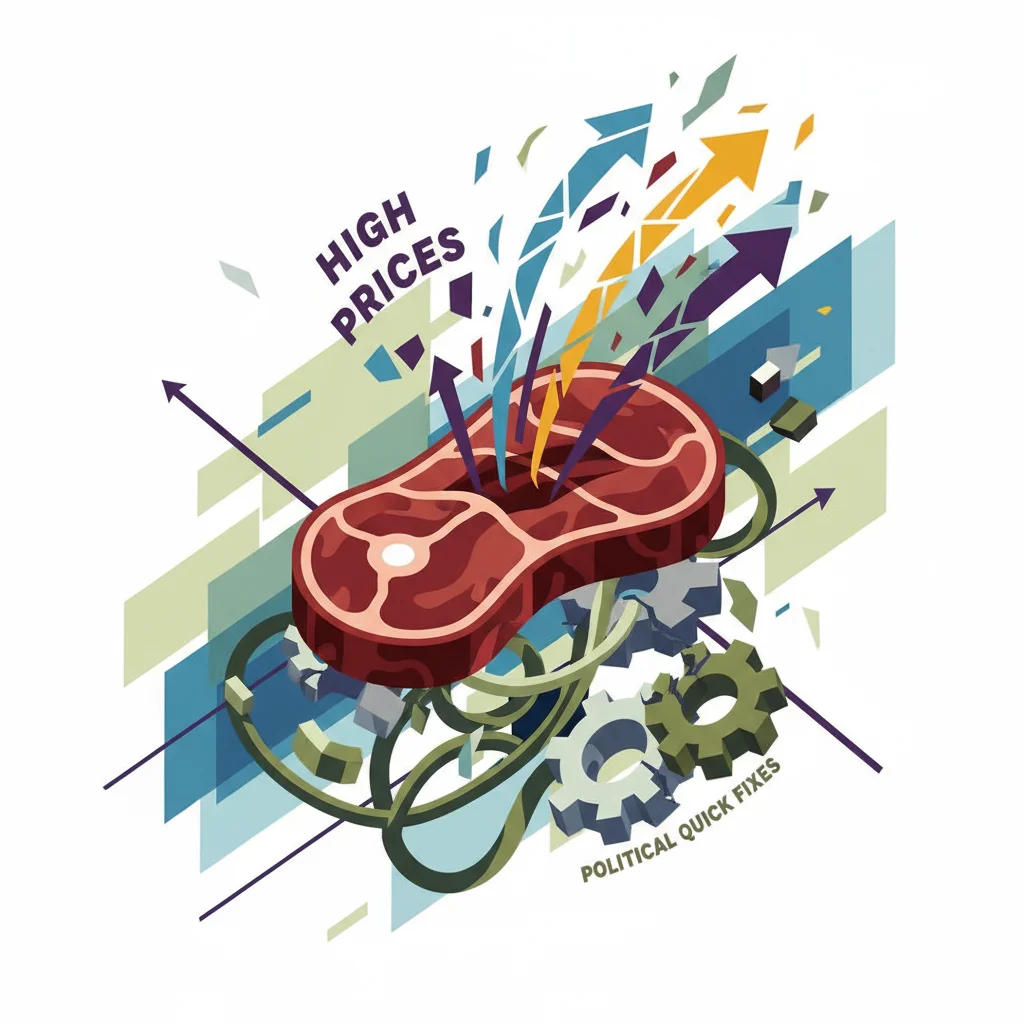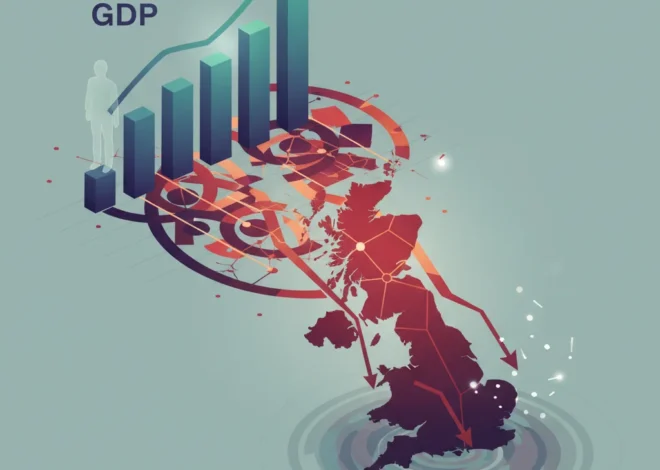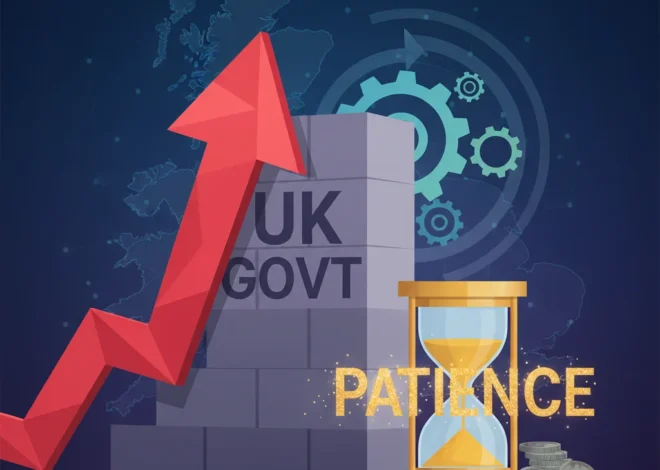
The $20 Steak: Deconstructing High Beef Prices and the Flaws in Political Quick Fixes
That steak dinner is costing you more than ever, and it’s not just your imagination. The sticker shock at the butcher counter is a tangible symptom of a complex economic issue that has found its way into the heart of the political arena. With U.S. beef prices reaching near-record highs, former President Donald Trump has proposed solutions he claims will bring relief to consumers. However, the very people at the start of the supply chain—the ranchers—are raising the alarm, arguing these plans are a superficial fix for a deep-rooted problem. According to a report from the BBC, ranchers have criticized the proposals for addressing “symptoms not the problems.”
This debate is more than just about the price of ground beef; it’s a case study in market concentration, supply chain fragility, and the intricate dance between policy, economics, and consumer welfare. For investors, business leaders, and anyone interested in the health of the U.S. economy, understanding the forces driving this inflation is crucial. It reveals vulnerabilities in our food supply system and offers a glimpse into how political rhetoric often clashes with economic reality, impacting everything from the stock market to your personal finance.
The Real Culprit: Unpacking the Beef Industry’s Structural Flaws
Before we can evaluate any proposed solution, we must first diagnose the illness. The high price you pay at the store isn’t simply because ranchers are charging more. In fact, many ranchers feel squeezed themselves. The core issue lies in the middle of the supply chain: the processing sector. The U.S. beef packing industry is a classic example of an oligopoly, where a small number of firms dominate the market.
Four companies—Cargill, Tyson Foods, JBS, and National Beef Packing—control over 85% of the U.S. beef processing market, according to data from the USDA. This extreme concentration gives them immense power over both the prices they pay ranchers for cattle and the prices they charge wholesalers and retailers for processed beef. When ranchers have few potential buyers for their cattle, they lose bargaining power. Simultaneously, when retailers have few suppliers, they are forced to accept higher wholesale prices, which are then passed on to consumers.
This structural imbalance has been exacerbated by recent events. The COVID-19 pandemic exposed the fragility of this concentrated system, with shutdowns at a few major plants causing massive supply chain disruptions. Furthermore, persistent droughts in key cattle-raising regions have forced ranchers to shrink their herds, reducing the overall cattle supply and adding further upward pressure on prices.
To put this in perspective, let’s look at how beef prices have outpaced general inflation. While overall inflation has been a major story in the post-pandemic economy, the rise in beef costs has been particularly stark.
| Year | Average Annual CPI Increase | Average Annual Uncooked Ground Beef Price Increase |
|---|---|---|
| 2020 | 1.2% | 6.5% |
| 2021 | 4.7% | 7.2% |
| 2022 | 8.0% | 7.7% |
| 2023 | 3.4% | 5.5% |
Source: Data compiled and synthesized from the U.S. Bureau of Labor Statistics (BLS) Consumer Price Index reports.
This data illustrates a persistent trend: the cost of beef is not just rising with everything else; it’s often leading the charge, driven by factors unique to its market structure. The Dragon's Grip: Why China's Social Crackdown is a Critical Red Flag for Global Investors
Political Solutions vs. Economic Realities
This brings us to the political proposals aimed at taming beef prices. While specific details of Trump’s plan remain fluid, they often revolve around pressuring processors, investigating price-fixing, or potentially implementing price controls. The ranchers’ criticism, as noted by the BBC, is that these measures fail to address the fundamental lack of competition.
From an economics standpoint, price controls are notoriously problematic. They can lead to shortages, create black markets, and ultimately disincentivize production without fixing the underlying supply issue. Investigating anti-competitive behavior is a valid and necessary function of government, but it’s a long, arduous legal process that offers no immediate relief. The core problem—that a rancher in Montana might only have one or two viable buyers for their entire herd—remains unsolved by these top-down approaches.
The Investor’s Perspective: Where’s the Money Flowing?
For those involved in investing and finance, this situation is more than a headline—it’s a data point. The dominance of the “Big Four” processors has direct implications for the stock market. Companies like Tyson Foods (TSN) are major players in investment portfolios, and their profitability is directly tied to their ability to manage the spread between what they pay for livestock and what they sell beef for. Any serious policy shift aimed at increasing competition could impact their margins and, consequently, their stock price.
Commodity traders also watch this space closely. Cattle futures, traded on exchanges like the Chicago Mercantile Exchange (CME), are a key instrument for hedging and speculation. The volatility in beef prices, driven by weather, policy announcements, and supply chain news, creates a dynamic environment for trading. Understanding the structural issues in the physical market provides a significant edge in interpreting futures market movements.
The table below breaks down the key issues and how different stakeholders are affected, from the rancher to the investor.
| Stakeholder | Primary Challenge | Financial/Economic Impact |
|---|---|---|
| Ranchers | Lack of competition among buyers | Depressed cattle prices, reduced profitability, reliance on a few powerful processors. |
| Processors (“Big Four”) | Political/regulatory scrutiny | High profit margins, dominant market position, but risk of antitrust action. |
| Consumers | High retail prices | Reduced purchasing power, impact on household budgets, food inflation. |
| Investors | Policy and market volatility | Risk/reward in processor stocks (e.g., TSN), opportunities in commodity futures trading. |
This dynamic highlights the interconnectedness of our modern economy, where a problem on the farm directly influences sophisticated financial markets. Navigating the Storm: Why a Scuttled Emissions Deal Creates a Trillion-Dollar Crossroad for Global Finance
Can Technology Offer a More Sustainable Solution?
If political quick fixes are unlikely to work, where can we find a lasting solution? Increasingly, the answer may lie in technology, particularly financial technology (fintech) and blockchain.
Imagine a future where fintech platforms create more transparent, auction-style marketplaces for cattle. Such platforms could connect ranchers directly with a wider array of buyers, including smaller, independent processors, restaurants, and even consumer groups. This would break the stranglehold of the “Big Four” by introducing genuine price discovery and competition. The role of traditional banking could evolve to provide micro-loans and financing for these smaller processors, facilitated by new financial technology that lowers risk through better data and transparency.
Furthermore, blockchain technology offers a powerful tool for supply chain traceability. By creating an immutable record of a cow’s journey from farm to table, ranchers can prove the quality, origin, and ethical treatment of their animals. This allows them to differentiate their product and command a premium price, bypassing the commoditized system that benefits large processors. For consumers, it provides trust and transparency. For the market, it creates a mechanism for value to be based on verifiable quality, not just bulk processing efficiency.
These technological solutions represent a market-based approach that empowers producers and consumers, directly addressing the root cause of market concentration. They are not instant fixes, but they offer a pathway to a more resilient, competitive, and fair beef industry. Déjà Vu or a Different Devil? Unpacking the New Wave of US Banking Jitters
Conclusion: Looking Beyond the Political Noise
The soaring price of beef is a potent symbol of deeper economic issues. While political proposals may grab headlines, they often distract from the structural consolidation that has been decades in the making. The criticism from ranchers is a valid warning: treating the symptoms of high prices with policies like price controls or tariffs will not cure the underlying disease of a non-competitive market.
For consumers, the path to lower prices lies in fostering a more diverse and competitive processing sector. For those in finance and investing, the key is to look past the political rhetoric and analyze the fundamental market dynamics. The real story isn’t about one politician’s plan; it’s about the long-term trends in market structure, the potential for disruptive technology like fintech and blockchain to reshape an industry, and the enduring principles of economics that show how competition, not control, ultimately serves the entire economy best.


